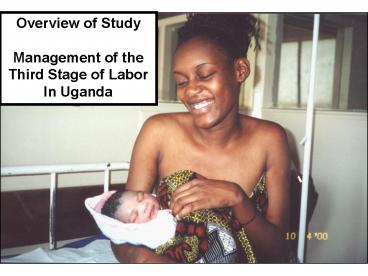Overview of Study - PowerPoint PPT Presentation
1 / 14
Title:
Overview of Study
Description:
Provide Ministry of Health/international partners the descriptive information ... International Federation of Gynecology and Obstetrics (FIGO) definition of AMTSL: ... – PowerPoint PPT presentation
Number of Views:34
Avg rating:3.0/5.0
Title: Overview of Study
1
Overview of Study Management of the Third Stage
of Labor In Uganda
2
Our ultimate goal
- Provide Ministry of Health/international partners
the descriptive information needed to assess
current practices regarding active management of
the third stage of labor (AMTSL). - Identify major barriers to its use.
- In order to
- Develop interventions to improve adoption and
implementation of the practice of AMTSL. - (Secondary aim) Produce public domain tools and a
methodology that could be employed by others in
the future to document change.
3
International Confederation of Midwives
(ICM)/International Federation of Gynecology and
Obstetrics (FIGO) definition of AMTSL
- Administering a uterus-contracting drug, e.g.,
oxytocin, within one minute of birth. - Applying controlled cord traction and counter
traction to the uterus. - Massaging uterus after delivery of the placenta,
as appropriate.
4
Variations of the definition of AMTSL
- Uterotonic drug some specify oxytocin (drug of
choice), other drugs have been used in the
literature (ergometrine, syntocinon,
syntometrine, prostaglandins). - Early or immediate cord clamping not
recommended by ICM/FIGO. - But for descriptive purposes we should collect
data on what is being done. - Some studies have omitted uterine massage.
- No studies to date looking at effectiveness of
the individual components of AMTSL.
5
What does AMTSL do for a woman?
6
Evidence on AMTSL
- Reduces incidence of postpartum hemorrhage by up
to 60 percent. - Reduces the quantity of blood lossthereby
decreasing incidence and severity of anemia. - Reduce emergencies and related cost, transport.
- Reduces the use of blood transfusion.
7
To date, there has only been one study to
document AMTSL practices internationally
Bulletin of the World Health Organization (WHO),
2003
8
Source Festin et al. 2003 Bulletin of the WHO
9
However, these data
- Are only from university teaching hospitals.
- (one health facility in each country, so this is
not a representative sample of deliveries in a
country) - Suggest that practices vary widely. People say
they are doing active management, but many of
them are using different definitions. - Do not tell us WHY providers do or do not use
AMTSL routinely.
10
Our study wants to describe
- How different providers/facilities define AMTSL.
- The barriers (and the facilitators) to routine
use of AMTSL.
11
Determinants of the use of AMTSL
Historical precedent, influence
of leader, WHO, in-service training
National guidelines
Policy
AMTSL protocol in hospital
Expected behavior in hospital
Presence in pre-service training
Champions for use of AMTSL
Woman receives AMTSL
Provider
Knowledge, skills in AMTSL
Implementation
Motivation to use
Proper storage
Sufficient availability of oxytocics, needles, syr
inge on site
Logistics
Amount procured
Transport issues
Procure- ment at hospital level
Uterotonics included on Essential Drug
List (oxytocin drug of choice)
12
Components of the survey re use of AMTSL
Historical precedent, influence
of leader, WHO, in-service training
National guidelines
Policy
AMTSL protocol in hospital
Expected behavior in hospital
Presence in pre-service training
Champions for use of AMTSL
Woman receives AMTSL (per ICM/ FIGO Statement)
Provider
Implementation
Skills in AMTSL
Know- ledge
Motivation to use
Proper storage
Sufficient availability of oxytocics, needles, syr
inge on site
Logistics
Amount procured
Transport issues
Procure- ment at hospital level
Uterotonics included on Essential Drug
List (oxytocin drug of choice)
13
We have divided our data collection so that
- The quantitative data has already been collected
analysis is underway. - This will be the qualitative part of the study
during which - You will interview health care providers about
their attitudes and practices in AMTSL. - You will interview community leaders, traditional
birth attendants, and community members about
PPH.
14
Remember your job is only to ask questions and
record responses
- You should NOT express your opinion about the use
of AMTSL. - You should NOT discuss the details of our study
with health care providers or other professionals
in health care facilities. - Simply say that this study is to document how the
third stage of labor is managed. We are simply
documenting common practices.































